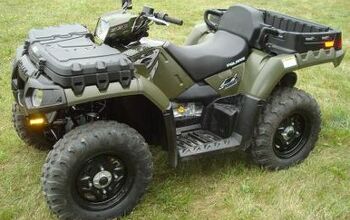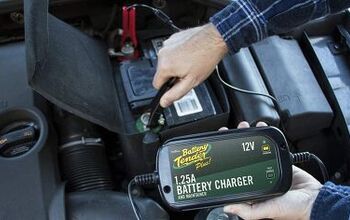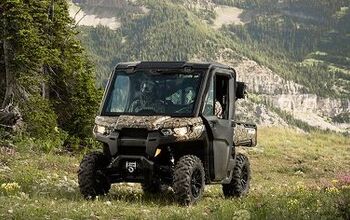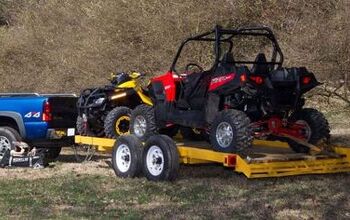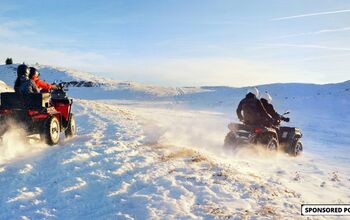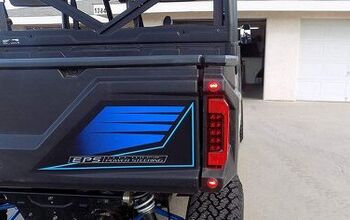2017 Honda Pioneer 1000 EPS vs. Kawasaki Mule Pro-FX LE + Video
One of the toughest jobs for a consumer in the off-road market might be finding the right machine for you. The numbers get confusing and the sales pitches are endless, but one thing is for certain; there is a seat for every rear end. In this comparison we take a look at the 2017 Honda Pioneer 1000 EPS and the Kawasaki Mule Pro-FX LE from several directions to help you find the correct machine for every day practicality on the farm or in the trails.
Our testing was compromised of tough terrain as well as hauling with a touch of towing thrown in to mix it up just a little. We also had some very fun trail rides at our leisure after the initial tests and we will share those here as well. We had to keep in mind during this testing that these are two machines possibly separated by manufacturer intent when it comes to the main course of activity. Time to dig in.
2017 Honda Pioneer 1000 EPS Review + Video
Just to give you an idea of our mindset going in, here are a few thoughts on individual machines. The Honda Pioneer 1000 feels as if it is more of a sporty recreational machine that boasts large displacement with higher percentage of the focus being adventure in our eyes. It has a definite working capability and a cargo bed to prove it, but with the heart of a lion waiting to roll out the trails. The shorter wheelbase and overall compact package seems to convince us of that.
The Kawasaki Mule, on the other hand, is more of the working machine feel that will get any number of traditional farming and ranching tasks done and can be trail ridden when the stress of the toughest job gets too high. Kawasaki’s Mule Pro-FX series is known as a hard working platform and the longer wheelbase as well as the grunt the powerplant puts out is our indication of its intended purpose.
2017 Kawasaki Mule Pro-FX EPS LE Review + Video
Starting with engine size, the Honda Pioneer definitely has an advantage on paper at 999cc. But when you look at how the Kawasaki is built and its 812cc triple cylinder powerplant, we cannot rule it out as a robust competitor. One thing about the Honda Pioneer that gets your attention quickly is the responsiveness of the engine. The throttle is linked, in spirit and action, to a quick responding thrust of forward motion. The Kawasaki Mule has a very linear moving throttle response that gets wound up a bit more patiently; however, this engine delivers a tremendous amount of torque or grunt for that heavy work day. The Honda Pioneer power builds productively and is controllable after mid-throttle where we feel the Mule seems to find its place about half to three quarter throttle and maintains that same linear feel with no real gains after this point. This will become more of an advantage when we get to the towing comparison, though. In short, the Pioneer 1000 does have more of a, in your face output when compared to the Mule. If you are looking from a working bloodline, though, the Honda’s power can become overwhelming at times during certain tasks and the calm “steady as she goes” feel from the Kawasaki Mule seemed to stand out in this situation.
When you look at the driveline of these machines, the Kawasaki Mule Pro-FX has the belt driven or CVT transmission shift on the dash via lever, where Honda has developed its automotive-style power automatic transmission delivery system. Honda refers to its gearing as a DCT, or dual clutch transmission. This system is very similar to an automobile when it shifts in auto-mode or it can be controlled by the paddles behind the steering wheel as an override of sorts. You can switch to Manual mode via a dash-mounted switch and do it all yourself if you wish.
Kawasaki’s Mule and its standard CVT or belt drive is proven and really tough. While you do notice the shifting of the Honda, it is not overbearing once out of first gear. All other shift points are pretty smooth with Honda’s DCT. Kawasaki’s Mule Pro-FX using the belt drive is seamless and linear as for delivery in the cab feel. Both of these systems work very well and there are benefits for both.
Both of these machines have dual A-arm suspensions and out of all of the Utility machines we have tested over this year these two are very well suited for both cargo bed weight as well as towing capability. The shocks on both machines are coil over, gas charged and preload adjustable and both are set up for work. The Honda seemed to have a bit better “fast pace” manner over the Kawasaki Mule, but when it comes to comfort the Mule Pro-FX did not disappoint at all. It was actually surprisingly comfortable for a heavy duty, working beast!
The cargo capacity for both the Honda Pioneer and the Kawasaki Mule Pro-FX is exactly the same. The bed weight for these two is 1,000 lbs in 49 states and in California it is 600 lbs. We have no clue why this is, but it says it in the specs so we are going with it. The towing capacity is also 2,000 lbs per vehicle via a two-inch receiver hitch. Now that we are clear on their very compatible capabilities, it should be known that each machine pulls and carries the weight a little different.
The Honda really never noticed the bed weight and with the trailer hooked up and loaded, our Pioneer performed very well. The rear shocks remained tall and lost little if any ground clearance once loaded. The Pioneer would slow our cargo on down hills and provided plenty of power during the testing. With the power of the 999cc engine, getting this weight moving was not an issue and braking on the Pioneer handled the cargo well.
The Kawasaki Mule Pro-FX has exactly the same capacity and worked extremely well during our testing. The grunt of the triple cylinder engine was very controllable and smooth during our climb over rough terrain and gave a very confident feeling from the driver’s seat. This Mule also slowed the load on our descents and the rear suspension remained steady while maintaining most all of the unloaded ground clearance. The Kawasaki’s longer wheelbase and rock steady power delivery seemed to really shine during testing. When applied, braking was sufficient and provided plenty of stopping power.
When you slip into the cab of either of these vehicles you instantly feel comfortable. Both cabins are set up with every control within reach. The Kawasaki Mule Pro-FX has a very simple and straightforward controls and bench-style seating. This seating supports the driver and passengers well, although our ride revealed that a little more sculpting in the seating would help position the rider more in place on off-camber trails.
The Honda Pioneer has bolstered seats that seem to individualize the driver and passenger areas in the cab just a bit more. This not only keeps each person in their “area,” but as the speeds pick up and the trail gets a little rougher it helps you feel planted in the seat.
Both machines have tilt steering to allow for various sized drivers and driving position requirements.
Overall we were really impressed with how both machines felt in the cab. The Kawasaki was very impressive from the standpoint of a longer wheelbase machine with a flat bench seat on the trail. Both were comfortable at reasonable speeds on the trails.
Most people that buy a Utility UTV do so with the intention of putting it to work. And when you use these machines like these a lot and come to rely upon them, good warranty coverage is an important consideration. After all, repairs can get expensive.
The Honda Pioneer 1000 EPS comes with a one-year factory warranty, which is definitely on the high side of average for the industry. Kawasaki takes things a big step further with an industry leading three-year warranty. Nobody else comes close to that kind of coverage.
Looking at both of these machines it would be a mistake to pick an absolute single winner. I personally feel that if you have a light workday and really need a trail adventure machine more than a worker then you should look towards the Honda Pioneer. However, if you need a lot of work with the capability of a machine to run fence lines or explore new property then the Kawasaki Mule is a great candidate. It is so hard to decide on one, but I promise you that either of these will make a fantastic ride in anyone’s book.
Whether he is in Mexico covering the Baja 1000, building ATVs for local racers, or out enjoying the trails, Rick’s passion shows in his stories. Learning to wrench his own machines from his grandfather, Rick also has an undying appreciation for the mechanics of off-road vehicles. Do not let the dirt and mud fool you, though, as Rick also has a deep love for street cars.
More by Rick Sosebee



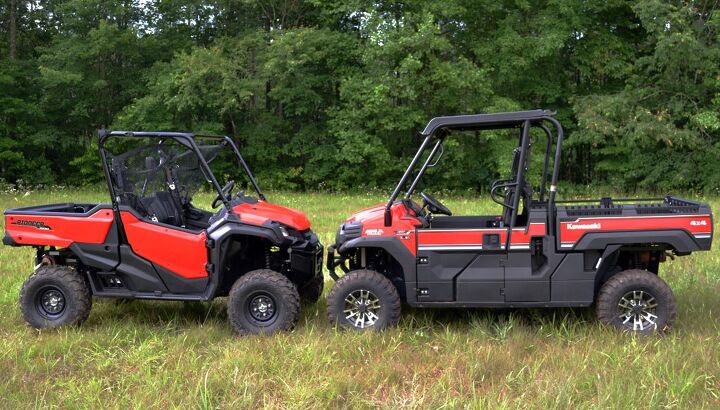
















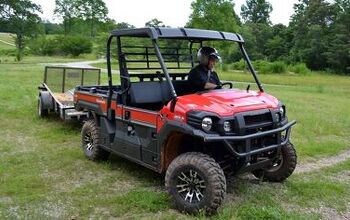
![Don't Try This at Home: Jet Ski Pulled by ATV [video]](https://cdn-fastly.atv.com/media/2022/10/24/8744130/don-t-try-this-at-home-jet-ski-pulled-by-atv-video.jpg?size=350x220)




